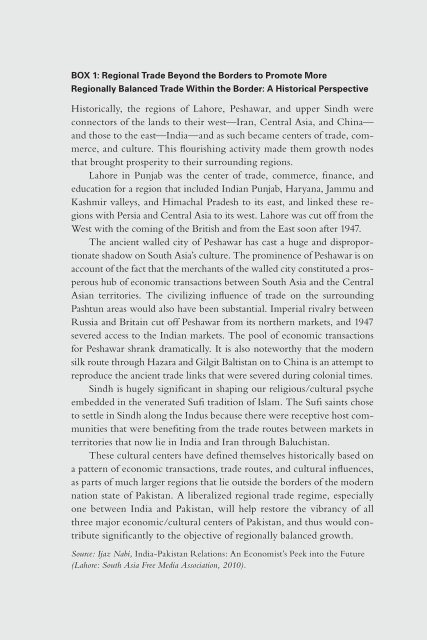You also want an ePaper? Increase the reach of your titles
YUMPU automatically turns print PDFs into web optimized ePapers that Google loves.
BoX 1: regional <strong>Trade</strong> Beyond the Borders to Promote More<br />
regionally Balanced <strong>Trade</strong> Within the Border: a historical Perspective<br />
Historically, the regions of Lahore, Peshawar, and upper Sindh were<br />
connectors of the lands to their west—Iran, Central Asia, and China—<br />
and those to the east—<strong>India</strong>—and as such became centers of trade, commerce,<br />
and culture. This flourishing activity made them growth nodes<br />
that brought prosperity to their surrounding regions.<br />
Lahore in Punjab was the center of trade, commerce, finance, and<br />
education for a region that included <strong>India</strong>n Punjab, Haryana, Jammu and<br />
Kashmir valleys, and Himachal Pradesh to its east, and linked these regions<br />
with Persia and Central Asia to its west. Lahore was cut off from the<br />
West with the coming of the British and from the East soon after 1947.<br />
The ancient walled city of Peshawar has cast a huge and disproportionate<br />
shadow on South Asia’s culture. The prominence of Peshawar is on<br />
account of the fact that the merchants of the walled city constituted a prosperous<br />
hub of economic transactions between South Asia and the Central<br />
Asian territories. The civilizing influence of trade on the surrounding<br />
Pashtun areas would also have been substantial. Imperial rivalry between<br />
Russia and Britain cut off Peshawar from its northern markets, and 1947<br />
severed access to the <strong>India</strong>n markets. The pool of economic transactions<br />
for Peshawar shrank dramatically. It is also noteworthy that the modern<br />
silk route through Hazara and Gilgit Baltistan on to China is an attempt to<br />
reproduce the ancient trade links that were severed during colonial times.<br />
Sindh is hugely significant in shaping our religious/cultural psyche<br />
embedded in the venerated Sufi tradition of Islam. The Sufi saints chose<br />
to settle in Sindh along the Indus because there were receptive host communities<br />
that were benefiting from the trade routes between markets in<br />
territories that now lie in <strong>India</strong> and Iran through Baluchistan.<br />
These cultural centers have defined themselves historically based on<br />
a pattern of economic transactions, trade routes, and cultural influences,<br />
as parts of much larger regions that lie outside the borders of the modern<br />
nation state of <strong>Pakistan</strong>. A liberalized regional trade regime, especially<br />
one between <strong>India</strong> and <strong>Pakistan</strong>, will help restore the vibrancy of all<br />
three major economic/cultural centers of <strong>Pakistan</strong>, and thus would contribute<br />
significantly to the objective of regionally balanced growth.<br />
Source: Ijaz Nabi, <strong>India</strong>-<strong>Pakistan</strong> Relations: An Economist’s Peek into the Future<br />
(Lahore: South Asia Free Media Association, 2010).<br />
| 40 |


